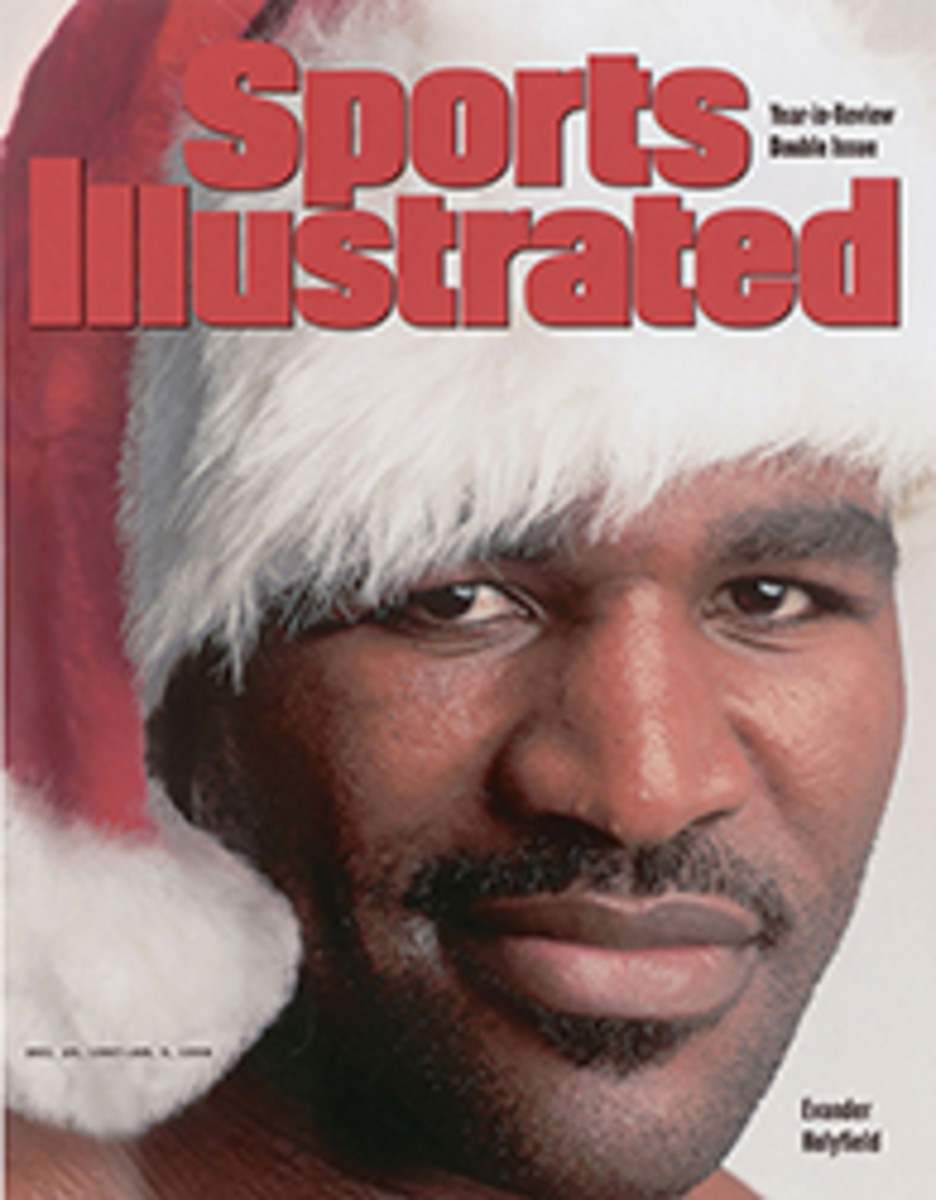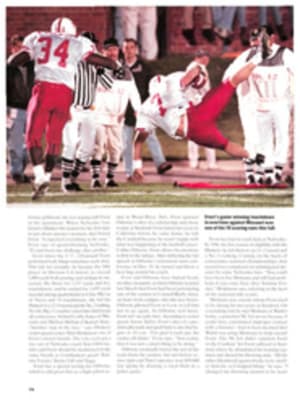
MODELED ON A MYTH EDDIE EAGAN OUTDID HIS HERO, FRANK MERRIWELL, WITH GOLD IN BOXING AND BOBSLEDDING
For nearly two decades, first at boarding school and then at
Yale, Frank Merriwell was an athlete of unmatched versatility,
courageous in the clutch, always a good sportsman. Off the field
he was even better. He exemplified, according to Robert H.
Boyle, author of Sport: Mirror of American Life, "truth, faith,
justice, the triumph of right, mother, home, friendship,
loyalty, patriotism, the love of alma mater, duty, sacrifice,
retribution, and strength of soul as well as body."
In fact, Merriwell was too good to be true. He was a fiction
dreamed up by a writer named Gilbert Patten in the late 19th
century. Using the pseudonym Burt L. Standish, Patten spun tales
of Merriwell's achievements in the pages of Tip Top Weekly, the
nation's most widely read dime-novel series of the day.
At their peak the Merriwell stories were reaching several
hundred thousand youngsters each week. One of the readers was a
boy named Eddie Eagan. And while nobody has quite lived up to
the standard created by Patten, Eagan may have come closest.
That, in fact, was his goal.
Eagan is often cited, erroneously, as the only athlete to win
gold medals at both the Summer and Winter Olympics. He wasn't.
Swedish figure skater Gillis Grafstrom won the gold medal when
skating was a summer event in 1920 and then, after the sport was
moved to the Winter Games, won twice more, in 1924 and 1928. But
Eagan remains the only person to have been golden in two sports
in different seasons. Along the way, he epitomized the
Merriwellian model and the Olympic ideal.
Eagan was born in Denver on April 26, 1898, two years after the
first Merriwell story appeared. His father, John, was killed in
a railroad accident in 1899. His mother, Clara, supported her
five sons by teaching German and French.
By the time Eddie was in high school, he had developed into a
talented amateur boxer. His coach, Abe Tobin, advised him to
continue his education rather than turn professional. Tobin
needn't have bothered. Eagan had vowed to live his life the way
his fictional hero, the ultimate amateur, did, chasing
perfection in and out of sports. In 1932 Eagan wrote, "To this
day I have never used tobacco, because Frank didn't. My first
glass of wine, which I do not care for, was taken under social
compulsion in Europe. Frank never drank."
After spending a year at the University of Denver, where he won
the western amateur middleweight title, Eagan enlisted in the
army at age 20, serving as an artillery lieutenant in France
during World War I. He then enrolled at Yale, following in
Merriwell's footsteps.
As captain of Yale's boxing team, he competed in the 1919 AAU
championships, losing a close decision in the light heavyweight
class but returning later that evening to win the heavyweight
title. Later that year Eagan competed in the Inter-Allied Games
in Paris and won the middleweight championship. In 1920, as the
light heavyweight representative on the U.S. boxing team at the
Summer Olympics in Antwerp, he defeated fighters from South
Africa, Great Britain and Norway en route to the gold medal.
After graduating from Yale in 1921, Eagan went to Harvard Law
School but left after a year when he was awarded a Rhodes
scholarship. From 1922 to '25 he studied at Oxford, continuing
his law education, and also boxed. He was the first American to
be crowned amateur champion of Great Britain. He made the U.S.
Olympic boxing team again in 1924, a rarity even then, but was
eliminated in the first round in the heavyweight division.
Much of the Frank Merriwell saga deals with the hero's travels.
Naturally, after Oxford, Eagan took a two-year world tour. "He
was really a world champion," his wife of 39 years, Peggy, once
explained. "He and a friend took a trip around the world, and in
every country Eddie challenged the amateur champion. He finished
the tour undefeated. So when you talk about undefeated
champions, my husband was one of them."
During his stay in England, Eagan participated in several boxing
exhibitions with Jack Dempsey, a fellow Coloradan. But when he
returned Stateside, he helped the new professional heavyweight
champion, Gene Tunney, train for what would become his famous
"long count" rematch with Dempsey in 1927.
After that Eagan settled into a promising legal career, and
boxing faded into the background. But in 1932 he took up a
different sort of bobbing and weaving.
Jay O'Brien, head of the U.S. Olympic Bobsled Committee, was a
good friend of the Eagans'. "One night," Peggy Eagan recalled,
"Eddie came back from dinner with Jay and said, 'Guess what. I'm
on the United States bobsled team.'" A member of the four-man
team had opted to compete in the two-man event, and unseasonably
warm temperatures had prevented the committee from holding
formal Olympic trials. With time running short, O'Brien turned
to his old friend. "I was practicing law at the time and finding
it a little cobwebby," Eagan explained. "I felt the change would
do me good."
Still, there were some, like W.O. McGeehan of the New York
Herald Tribune, who believed the sport was beneath a man like
Eagan. "It is a shame," McGeehan wrote, "that Mr. Eagan,
educated at Yale and Oxford and with a fine bringing up in every
way, should turn out to be only a bobsledder."
Ah, but he forgot Frank Merriwell, who was so multitalented that
he made Jim Thorpe look one-dimensional. Merriwell starred in
baseball, football, hockey, tennis, track, crew, fencing,
lacrosse, golf and bicycle racing. So for Eagan--who had
excelled in collegiate tennis, fencing, swimming and wrestling
as well as boxing--bobsledding was a natural.
A bobsled is dangerous even for experienced sledders, and Eagan
had never been in one until he arrived at Lake Placid for the
1932 Games. No matter. Courage was a Merriwellian must. "Eddie
was absolutely fearless," Peggy recalled. "He would try
everything just for the thrill of it. After a few practice
sessions they [the team] performed like they had been together
for years."
The men in Eagan's sled were an eclectic bunch. The driver was
20-year-old Billy Fiske, described by Olympic historian Bud
Greenspan as a "socialite daredevil" who had won the gold four
years earlier when it had been contested, for the only time, as
a five-man event. Eagan was in the second spot. Behind him was
Clifford (Tippy) Gray, who had been in Fiske's sled in 1928. A
40-year-old songwriter, Gray would write some 3,000 tunes over
the years. The brakeman was O'Brien, one year shy of 50.
A raging blizzard played havoc with the schedule, forcing
several events, including the four-man race, to be delayed.
After three days, the first two heats were held on the last day
of competition, but the athletes protested the poor racing
conditions. So, in what may have been an Olympic first, the
final two heats took place the following day--after the closing
ceremony.
Eagan's sled was fastest in each of the first three heats. The
fourth run, however, included a heart-stopping moment when one
of the sled's runners crept over the edge at a treacherous turn
known as White Face. "Picture a steel comet with four riders
hurtling through the air," Eagan later reflected. "We missed
becoming that only because Billy Fiske was at the wheel." Fiske
steadied the sled and cruised to victory with a combined time
two seconds faster than that of the silver medal sled, also a
U.S. foursome. It was one of a dozen gold medals the Americans
earned in Lake Placid, the only time the U.S. has won the most
gold at a Winter Olympics.
The foursome never raced together again. All but Eagan were dead
within a decade. O'Brien succumbed to a heart attack. Fiske, the
first American to join the British Royal Air Force, in 1939,
also became the first to be shot down. Gray died in 1941,
without ever having told his children he had won two Olympic
gold medals.
Following the 1932 Games, Eagan served as assistant U.S.
attorney for Southern New York. But soon he was presented with
another chance to add to his heroic resume. In 1941, when the
U.S. entered World War II, Eagan joined the Army Air Corps,
becoming chief of special services in the air-transport command.
By the end of the war he had earned the rank of lieutenant
colonel.
Eagan returned to civilian life and continued to play a role in
American sports development, including stints as head of the New
York State Athletic Commission, chairman of President Dwight
Eisenhower's People-to-People sports committee (a sort of
athletic ambassadorship to the world) and director of the sports
program for the 1964 New York World's Fair.
He died of a heart attack in 1967, six weeks after his 69th
birthday. Sixteen years later, Eagan was one of the inaugural
inductees--along with Jesse Owens, Wilma Rudolph, Mark Spitz and
Eric Heiden, among others--into the U.S. Olympic Hall of Fame.
Frank Merriwell can't claim that.
Brad Herzog, who lives in Pacific Grove, Calif., is a frequent
contributor to SI.
B/W PHOTO: UPI/CORBIS-BETTMANN Eagan was quick enough with his fists to head the Yale team and become British amateur champ while a Rhodes scholar. [Eddie Eagan]
B/W PHOTO: UPI/CORBIS-BETTMANN Before being invited to join the 1932 Olympic team, Eagan (behind driver) hadn't ridden in a bobsled. [Billy Fiske, Eddie Eagan, Clifford (Tippy) Gray, and Jay O'Brien in bobsled]

